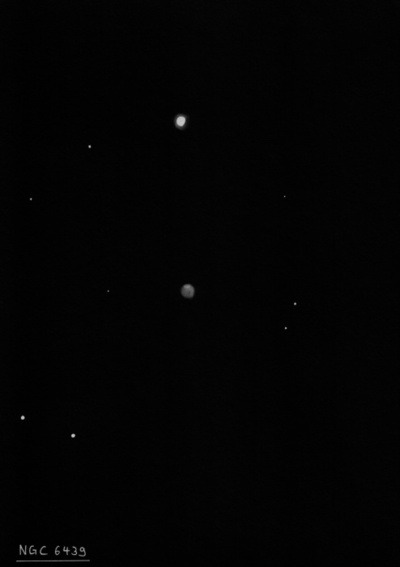
Edward Pickering discovered NGC 6439 on 18 Aug 1882 with the 15-inch refractor at Harvard College Observatory using a direct-vision spectroscope. He reported the discovery in AN 2459 and Sidereal Messenger, Oct 1882 and noted "mag 13. A star, mag 11, north 1' and follows 1 second." His position and description is accurate. Megastar (and probably other sources) misidentify the mag 13 star that is 1' north as NGC 6439.
Based on Crossley photographs at Lick, Curtis (1918) described NGC 6439 as "a minute round disk 5" in diameter, there is a very wind in p.a. 290°. The disk is slightly fainter at the edges."
300/350mm - 13.1" (7/12/86): fairly bright stellar planetary at 79x, verified with OIII blinking. At 166x a mag 10.5 star just 1.2' N is perfectly placed for blinking comparison! Appears stellar at 214x. Estimate V = 12.0-12.5.
400/500mm - 18" (7/25/06): easily picked up at 115x as a quasi-stellar light-blue mag 12.5 "star" just 1' S of a mag 10.4 star. Very good response to the OIII filter. A very small disc was visible at 225x, perhaps 3" in size. Adding a UHC filter this compact planetary was similar in brightness to the mag 10.4 star and appeared to increase slightly in diameter. At 435x a small oval, ~4"x3" was resolved of uniform surface brightness except it seemed to fade around the periphery, hinting at a thin faint envelope. Located in the NW corner of Sgr near the border of Ophiuchus and Serpens Cauda.
Notes by Steve Gottlieb